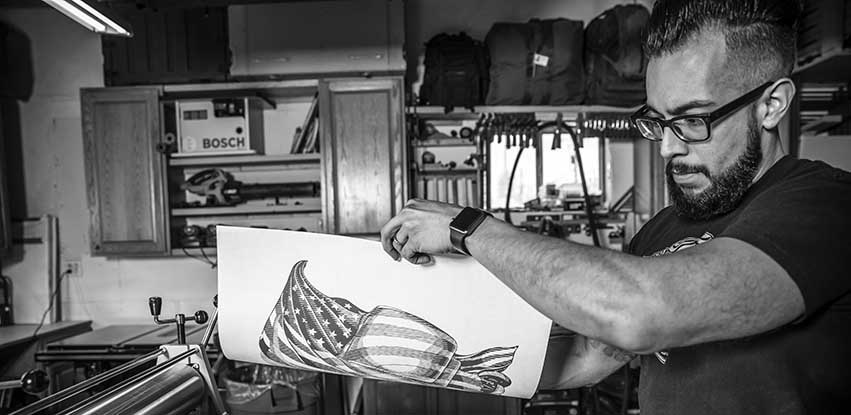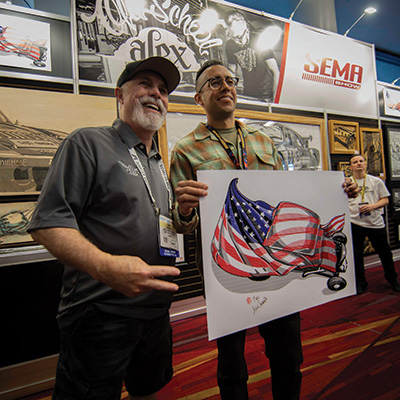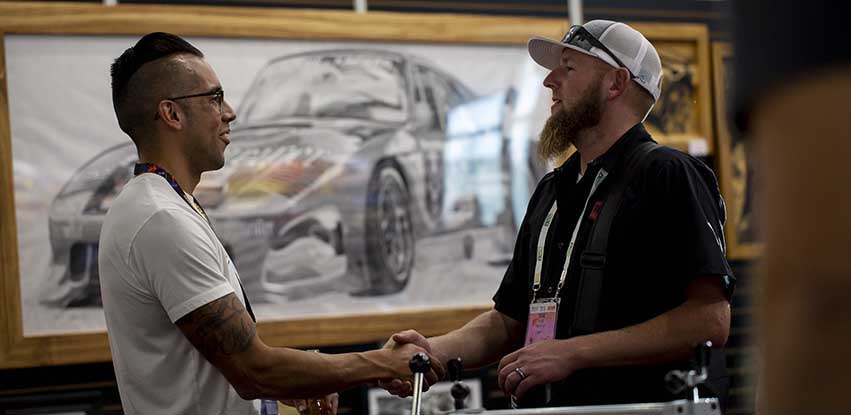On Selling Art

I recently got an email asking me how to sell art. This is a very hard question to answer because it has a lot of moving pieces to it. And like any business, if all the parts of your business aren’t running cohesively, you’re going to fall short. I know artists just want to be artists, but in order to be successful, you have to learn to be disciplined and take care of all the details. If you decide to take shortcuts to save a buck, you’ll hurt your chances of success. I wanted to spend some time talking about selling art in person, since selling art on the internet is a whole different ballgame.
Find the Right Outlet
First you need to find an outlet to sell your work. This could be art fairs, trade shows, a street corner, or in my case, car shows. I started selling my artwork at car shows because most of my art is centered around car culture. Do you have a certain subculture that you can leverage to get pieces sold?
Maybe you paint a lot of pictures of whiskey glasses and bar-related art. If this is the case, you should think outside the box. Perhaps you can sell this type of art at the next cigar convention? Yes, there are conventions for damn near everything these days. If you are that person who loves to paint whiskey and bar art, you have to find shows that attract people who share those interests. A cigar convention may not sound like the best place, but I’ll bet bar-related art has a great chance of success because whiskey and cigars go hand-in-hand. It’s up to you as an artist to find these types of connections, so you can get your art in front of the right people.

Setting up at art fairs is great, but you’ve only connected one dot by selling there. People go to art fairs because they love art. It’s always better to seek out shows that can connect multiple dots. If you make a lot of art that depicts the craft beer market, then take a chance and set up at a brewery over the weekend, or pay for a booth at the Great American Beer Festival. People don’t necessarily look to buy art when you do shows that aren’t art-based, but they love to spend money on their interests. If you’re confident in the quality of your artwork, then I would recommend trying this approach.
Although being an artist is about expressing yourself, creating something from nothing, and all that artsy stuff, you’ll still be better off making calculated decisions when it comes to venues to sell in. Will you always be successful? Hell no, you won’t. It’s up to you to be persistent, and continue to adjust your approach when things aren’t working out.
Spend a Little Money
Have you ever heard that old expression, “You have to spend money to make money…”? As cliché as it sounds, there’s a ton of truth to it. Booth fees can be cheap, but they’re oftentimes expensive as hell—especially if it’s a big show with a lot of spectators. Oh, and do you have a booth to hang your work in? Did you make sure to frame all your artwork so your presentation is as professional as possible? Are you going to have travel expenses like fuel, food, hotels or Airbnbs?
Even after I paid for a booth, table, chair, checkout stand and everything else needed to run a show, I would usually average somewhere around $1,500 to $2,000 in expenses just to get there. Granted, I usually traveled far for shows, but it’s what I had to do if I wanted better chances to sell my art. Being a “starving artist” is hard, but if you don’t take some chances, your odds of coming out on top and actually making this a career are slim. So spend that money!
Be Nice and Say Hello
My approach to selling is very simple. Step one: Be nice. Step two: Be NICE! Really, this is the most important thing when it comes to selling a complete luxury. I have approached artists who I admired for a very long time and was so put off by the way they treated me that I stopped supporting their work. I don’t care if you know you’re the best artist in the room, or the entire world for that matter! Always treat people with respect—especially since your goal is to have them exchange their hard-earned money for something you made in your basement. Don’t forget to be kind to everyone, even if you know they aren’t going to buy anything. There’s always a chance they may know someone who will, or more importantly, they may turn into a lifelong friend—it’s happened to me many times. Keep this rule and engrain it into your everyday life.
Get ready for step three: Always greet someone who comes into your booth. Don’t be scrolling through Facebook or taking a nap. Believe me, I’ve seen it. You greet people because it’s disrespectful not to, and the greeting will open up some conversation with most people. Some artists have a hard time talking to potential customers for fear of rejection. This is an idea your own ego creates, and you should toss all of those fears in the trash. People may be rude to you or ask silly questions. They will tell you what you should be doing. All of this is okay, and it’s something you need to get used to. Don’t let it stop you from achieving your goals.

Have a Story to Tell
Now that you know how to be nice and say hello to people, we can move on. Make sure to have a short script or a story about your art—you don’t want to pester a customer the entire time they’re in your booth. Be helpful and informative when you need to, but don’t be circling them like a vulture. I always make sure to let people know the process of creating my artwork and where the prices are. I also let them know that a lot of pieces are also available unframed. After that I just tell them to let me know if they have any questions and I leave them alone, for the most part. You will be surprised how many people have questions and want to talk to you about your work. If they show interest in conversing with you, then by all means talk to them.
That’s it—nothing more! If they like your work, they might buy it, but remember: They either get it or they don’t. There’s never a good time to be pushy. Selling art isn’t like selling a car, at least it’s not to me. Could you imagine asking a potential buyer what you would have to do to get them into this new painting? What if I could take $100 off? No! They either like it or they don’t. I’ve sold cars before, and trust me, that was the most stressful job of my life.
Don’t stress yourself out about making sales. If you have a good product, it will sell itself. What’s more important, in my opinion, is positioning yourself in a place that brings the customers you need: people who are into your subject matter. Finally, be respectful and make sure your setup looks professional… You want to show people that you are serious about your work—that it’s not just an afterthought. PM
Adapted, with permission, from a blog post at oldschoolalex.com. Follow Alex Carmona on Instagram @TheRealOldSchoolAlex or find him on Facebook to learn more.
- Log in to post comments

